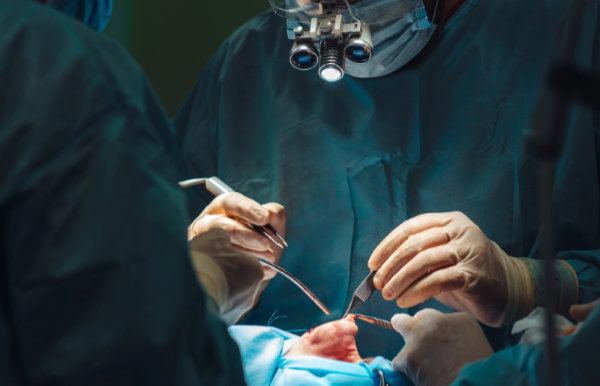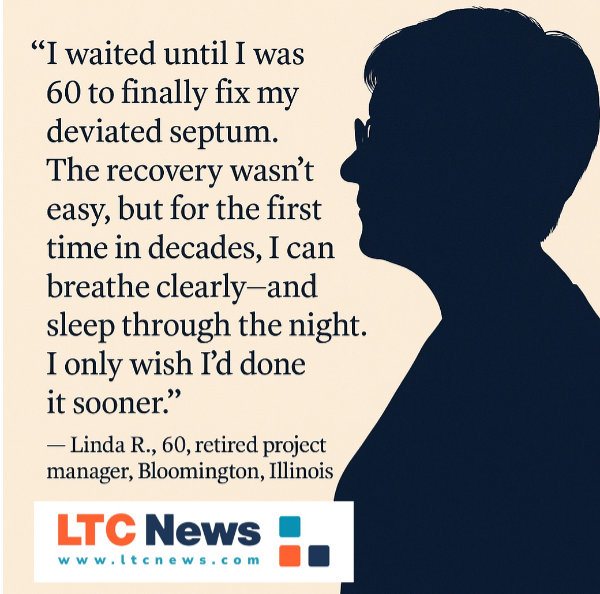Rhinoplasty — How to Heal Faster, Breathe Easier, and Age Confidently

You might think of rhinoplasty—or a “nose job”—as something reserved for the young or image-conscious celebrities. However, today, more adults over 50 are opting for rhinoplasty for both cosmetic and functional reasons. Whether you want to correct a bump, improve symmetry, or alleviate breathing problems caused by a deviated septum or aging nasal structures, this procedure can offer significant benefits.
As we age, changes in skin elasticity, bone density, and cartilage structure can alter the shape and function of the nose. This can cause the nasal passages to narrow, leading to chronic congestion, sinus infections, sleep disturbances, or mouth breathing.
Functional rhinoplasty is often used to correct a deviated septum, enlarge narrowed airways, or repair internal valve collapse—all of which can significantly improve breathing. Some patients also seek rhinoplasty to address issues related to past trauma, chronic snoring, or sleep apnea.
These functional issues can impact overall health in subtle but important ways. Poor airflow through the nose can reduce oxygen intake during sleep, increase fatigue, raise blood pressure, and lead to restless nights. Restoring proper nasal structure not only improves breathing comfort, but it may also enhance your energy levels, focus, and even cardiovascular health. In short, a well-functioning nose supports better quality of life and long-term wellness.
In these cases, rhinoplasty can restore both appearance and comfort.
Performed by a board-certified facial plastic surgeon or otolaryngologist (ENT specialist), rhinoplasty typically involves reshaping nasal cartilage and bone through incisions made inside the nostrils or across the columella (the strip of tissue between the nostrils). The procedure may be done under general anesthesia or IV sedation and usually takes 1.5 to 3 hours.
Recovery, no matter your age, is a journey—especially as we get older. Healing can take longer, swelling may linger, and complications can be slightly more common due to underlying health conditions. But with the right approach, adults over 50 can experience excellent results.
This guide breaks down each phase of rhinoplasty recovery and offers expert-backed tips to help you heal faster, stay comfortable, and protect your investment in yourself.

The First Week: Laying the Foundation
1. Understand the rhinoplasty recovery timeline
Your body typically needs up to a year for full rhinoplasty recovery. However, the first seven days play a vital role in setting the tone for proper healing. Adults over 50 should be aware that reduced collagen production and slower cell regeneration can prolong recovery time.
Reviewing cosmetic rhinoplasty recovery tips during this period can help you manage swelling, stay comfortable, and avoid common mistakes. Note that the recovery tips for cosmetic rhinoplasty and medically necessary functional rhinoplasty (such as for a deviated septum) are largely similar. However, cosmetic patients are often more concerned with bruising, swelling, and the final appearance, while functional patients focus more on restored breathing and nasal airflow.
Either way, you’ll likely experience bruising and swelling, particularly around the eyes and cheeks. By the end of week one, your nasal splint is usually removed, and you’ll get a first glimpse of your reshaped nose—but don’t be discouraged if the appearance isn’t final. Significant internal healing continues. Many patients return to desk work or school after this first week.
2. Keep your head elevated at all times
Sleeping with your head elevated—at a 45-degree angle—helps reduce swelling by promoting healthy blood flow and preventing fluid buildup. Stack pillows or use a wedge pillow to maintain this position. Recliners work well, too.
Older adults may be more prone to swelling due to circulatory changes, so elevation is particularly important. Avoid bending over or lifting heavy objects, as this can increase facial pressure and prolong recovery.
3. Use cold compresses carefully
Apply cold compresses around your cheeks and eyes—not directly on the nose—during the first 48 to 72 hours. Use the 20-on, 20-off method for the first two days. This helps minimize bruising and swelling and improves comfort.
Wrap compresses in a soft cloth to protect your skin. After day three, reduce application to three or four times per day. If you have delicate or thinning skin, common with age, monitor closely for skin irritation or numbness.
Weeks 2–4: Building Momentum Safely
4. Avoid exercise and heavy lifting
While you may start feeling better, your nasal tissues are still fragile. Avoid activities that increase blood pressure, including lifting objects over 10 pounds or intense cardio.
For adults over 50, it’s especially important to prevent spikes in blood pressure that could cause nosebleeds or disrupt healing tissue. Light walking is encouraged to promote circulation.
Gradually reintroduce activity: 25 percent effort during week two, 50 percent in week three, and 75 percent by week four, with your surgeon’s approval.
5. Don’t blow your nose or sneeze forcefully
Your rhinoplasty recovery hits major milestones by week five.
Even if congestion is frustrating, forceful nose blowing can damage healing structures, so avoid blowing your nose for at least 7-10 days, but ideally 3-4 weeks. Adults with allergies or chronic sinus issues should discuss preventative care with their surgeon.
Tips:
- Use prescribed saline nasal sprays
- Dab gently with soft tissues (never wipe or blow)
- Use a cool mist humidifier in your bedroom
- Sneeze with your mouth open to reduce nasal pressure
6. Stay out of the sun and heat
Older skin is more prone to sun damage and discoloration. Sun exposure during healing can lead to pigmentation changes and worsen swelling.
Use SPF 30+ post-surgical sunscreen daily. Wide-brimmed hats add protection. Avoid hot showers, steam rooms, and direct sunlight for the first 6–8 weeks.
Weeks 5–8: Supporting Long-Term Healing
Begin with gentle exercise and simple tasks to gradually build up your strength and stamina.
7. Resume light activity with caution
By week five, your nasal bones and cartilage have gained strength, but still need protection. Adults over 50 may need more time to rebuild stamina. Begin with low-impact cardio, gentle yoga, or machine-based weights. Avoid high-impact sports or activities with a fall risk.
If you play contact sports, consult your surgeon about using a protective face mask. Most surgeons recommend waiting 6–8 weeks before full workouts.
8. Eat well and stay hydrated
Nutrition and hydration are critical to recovery. Healing slows with age, and nutrient absorption can decline over time.
Tips:
- Drink at least eight 8-ounce glasses of water daily
- Eat lean proteins (chicken, tofu, fish), fruits, vegetables, and high-fiber grains
- Limit sodium to reduce fluid retention
- Incorporate anti-inflammatory foods: berries, turmeric, ginger, leafy greens
9. Avoid smoking and alcohol
Nicotine and alcohol delay healing, increase swelling, and raise infection risk. For older adults, these substances may also compound age-related circulatory or respiratory concerns.
Nicotine restricts blood flow, reduces oxygen delivery, and impairs immune response. Alcohol can interact with medications, dehydrate your body, and slow tissue regeneration.
Most surgeons recommend abstaining from both for at least 6 weeks.
Ongoing Care and Patience
10. Don’t wear glasses until approved
Pressure from glasses can distort healing cartilage and create indentations. This risk increases with thinner or aging skin. Most surgeons recommend avoiding glasses for 4–8 weeks post-op.
Alternatives:
- Use contacts if possible
- Wear frames with forehead support
- Use your surgical splint under the frames
- Take frequent breaks from glasses
11. Monitor for unusual symptoms
Older adults may have a slightly higher risk of complications due to chronic conditions.
Call your surgeon if you experience:
- Severe pain that doesn’t improve with medication
- Persistent bleeding beyond 3–4 days
- Signs of infection (fever, redness, pus, warmth)
- Difficulty breathing
- Uneven or worsening swelling
12. Be patient with the healing process
Full results take up to 12 months—sometimes longer with age. The nasal tip is the last area to settle, and morning swelling may persist. Sensitivity or numbness may linger.
Experts say that healing from rhinoplasty is a marathon, not a sprint. The best outcomes happen when you take the full year of healing seriously—especially in the first six weeks.
Use SPF 50+ daily, avoid injury, and maintain good nutrition and hydration throughout the year.
Considerations for Older Adults
People over 50 should consult a board-certified facial plastic surgeon to evaluate candidacy for rhinoplasty. Age alone isn’t a disqualifier, but chronic conditions like high blood pressure, diabetes, or cardiovascular disease may require special care and extended monitoring.
Healing times may be longer, and skin quality or bone density can influence surgical planning and final outcomes. Be honest about your goals, medications, and health history.
Cosmetic vs. Functional Rhinoplasty: What’s the Difference with Insurance?
Cosmetic Rhinoplasty is primarily performed to enhance the appearance of the nose. It addresses concerns like bumps, crookedness, asymmetry, or size in relation to the face. This type of procedure is considered elective and is not covered by insurance.

Share your thoughts and experiences about aging, caregiving, health, and long-term care with LTC News —Contact Us at LTC News.
Functional Rhinoplasty is designed to improve breathing or correct structural issues that impair airflow. It may involve correcting a deviated septum, repairing internal nasal valves, or addressing issues caused by trauma, aging, or congenital defects.
When rhinoplasty is deemed medically necessary to restore proper breathing or function, it may be covered in part or in full by your health insurance—provided proper documentation and pre-authorization are submitted.
Insurance Coverage Tip: To improve your chances of insurance reimbursement for functional rhinoplasty, you may need:
- A CT scan or nasal endoscopy showing obstruction
- Documentation of failed medical treatments (e.g., nasal sprays, antihistamines)
- A letter of medical necessity from your ENT or plastic surgeon
Both procedures may be performed together. Talk to your surgeon and your insurance provider early in the process to clarify what’s covered and ensure you understand your financial responsibility.
Final Thoughts
A smooth rhinoplasty recovery depends on consistency, good habits, and patience. Small efforts—like cold compresses, sleeping with your head elevated, and avoiding high-impact activity—make a big difference in your results.
Pay close attention to sun protection, nutrition, hydration, and avoiding smoking or alcohol. Your age shouldn’t hold you back from achieving your goals, but older adults must approach recovery with care and informed guidance.
This article is for educational purposes only and does not substitute for professional medical advice. Always follow the specific instructions of your surgeon.
Related Resource:


